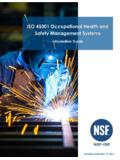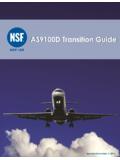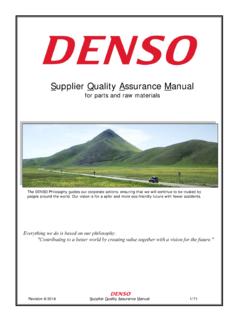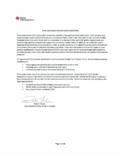Transcription of SUPPLIER ASSURANCE - NSF International
1 P a g e |1. SUPPLIER ASSURANCE Food Safety Expectations and Criteria for Food Processing Facilities . May 2014. Prepared by NSF International 789 N. Dixboro Road Ann Arbor, MI 48105. Version Version Date: May 3, 2014. Document Title: NSFI SUPPLIER ASSURANCE Audit Checklist for Food Safety Expectations and Criteria for Food Processing Facilities 2013 NSF International . This document cannot be reproduced in whole or in part without express written consent. The information contained herein is proprietary and confidential and is the property of NSF- International . P a g e |2. NSF International SUPPLIER ASSURANCE audits focus on the development, implementation and control of systems that impact Food Safety, Food quality and Food Defense.
2 The audit evaluates the adequacy of documentation, compliance to documented procedures, effectiveness of procedures to control the process within defined limits and the ability to implement corrective and preventive action plans. This manual provides criteria and expectations that the facility will be audited against and is generic for all types of food processing establishments. Some specific criteria may not be applicable. It is the responsibility of the manufacturer to justify that a specific criterion is not applicable. Likewise, additional criteria may be applied based on changing regulatory requirements, specific client needs or the ever-changing food safety and food defense environment.
3 Food defense is the terminology used to describe the actions that need to be implemented to prevent the intentional tampering with product to cause harm to the consuming public. Manufacturing plants located outside the and exporting to the shall meet customer expectations and (FDA, USDA, Department of Commerce (seafood) regulatory requirements. Where these expectations are applied in other jurisdictions for food not intended for export to the the regulations and customer expectations in those jurisdictions shall apply. The following expectations are based on customer specifications and: Food, Drug and Cosmetic Act (21 CFR) and appropriate amendments Food Code, 2013 edition (FDA/USPHS) and appropriate supplements Federal Meat Inspection Act (9 CFR) and amendments Poultry Products Inspection Act (9 CFR) and amendments Egg and Egg Products Inspection Act (EPIA) and amendments DOCUMENTS REVIEWED DURING THE AUDIT: This list is to provide guidance to the type of documents and procedures the auditor may ask to review during the audit.)
4 There may be additional documents, policies and procedures requested that are not included in this list. Some of these documents may not apply to your type of facility. When policies are stored electronically or held at a corporate location it is the facilities responsibility to demonstrate to the auditor that they are aware of where and how to access documents related to the facilities operations, policies and procedures. ADMINISTRATION AND REGULATORY COMPLIANCE. Plant management organization chart and QA responsibilities Food Safety and quality Policies and Procedures Manual Product list or proposed product list for client Product specifications for client or plant product specifications Policy and documentation of management and employee training Detailed Product Recall Manual, including records of mock recalls Regulatory compliance policies and documents of regulatory visits or comments Document management and record keeping policies and procedures Version Version Date: May 3, 2014.
5 Document Title: NSFI SUPPLIER ASSURANCE Audit Checklist for Food Safety Expectations and Criteria for Food Processing Facilities 2013 NSF International . This document cannot be reproduced in whole or in part without express written consent. The information contained herein is proprietary and confidential and is the property of NSF- International . P a g e |3. Change management policies to address changes in management, process or product specifications Emergency or catastrophic event product management program Policy compliance and effectiveness review program Consumer complaint policy & procedures and records HACCP MANAGEMENT. Current, signed HACCP Plan with team members designated HACCP Team member credentials Documented records of HACCP team program oversight Plans are available for auditor review Flow Chart of process Hazard analysis and documentation Critical Control Point (CCP) validation, including application of relevant process capability evaluations Monitoring and Corrective Action policies and documentation Rework policies and procedures in HACCP plan and Flow Chart Records Management & Security policies Verification and Validation procedures and documentation Prerequisite program documentation and performance records NOTE.
6 HACCP Plan must include the following: Identification of HACCP team Description of the food and its distribution Description of customer and intended use Documented detailed hazard analysis for all ingredients, process steps and products Detailed process flow charts, showing all inputs, outputs, and product rework/recycle pathways Annual review (at minimum) by HACCP team and signed by the most senior on-site executive responsible for the facility and its operation. Version Version Date: May 3, 2014. Document Title: NSFI SUPPLIER ASSURANCE Audit Checklist for Food Safety Expectations and Criteria for Food Processing Facilities 2013 NSF International .
7 This document cannot be reproduced in whole or in part without express written consent. The information contained herein is proprietary and confidential and is the property of NSF- International . P a g e |4. DEFICIENCY CLASSIFICATION AND GUIDELINES. Within the Expectation Manual, the following terms have these meanings: Shall or Must An absolute requirement of this expectation document. Should A strong suggestion for a component of a Food Safety/ quality System. Annually - a 12 month period. The audit report will not contain recommendations or suggestions for enhancement for improvement. The audit is intended as an objective assessment of the food safety management programs in a food facility.
8 Audit Question/Statement Answers Options: **Some expectations or elements are identified as Essential. A lack of compliance to these expectations shall cause audit failure. The Essential Elements are listed below. Acceptable ratings are awarded when the element being audited meets or exceeds the applicable expectation. Non-conformance is the assessment made when: a. The element being audited does not fully meet expectations of an element. b. Improvements are required to meet the expectation. Major Non-conformance . An assessment of Major non-conformance may be made when: a. Deficiencies of an element present a high probability of food safety or regulatory failure.
9 B. Significant improvement is needed to meet the expectations. c. HACCP requirements have not been fully documented or implemented d. An element of the standard has not been documented (if required) or implemented e. A situation is observed where, based on objective evidence, there is significant doubt as to the conformity of product being supplied. f. There are numerous findings of Non-conformance that indicate a lack or failure in a required section and a potential risk to product safety, quality or regulatory non- compliance exists. Critical Non-conformance . An assessment of Critical Non-conformance may be made when: a. There is objective evidence or direct observation that product is unsafe, could potentially cause serious illness, death or is a risk to health and is subject to a Class I or Class II recall.
10 B. The product or process does not meet regulatory requirements. c. There is failure to meet an Essential element of the expectations as listed in the standard. Note: Any Critical Non-conformance will result in a failure of the audit. Version Version Date: May 3, 2014. Document Title: NSFI SUPPLIER ASSURANCE Audit Checklist for Food Safety Expectations and Criteria for Food Processing Facilities 2013 NSF International . This document cannot be reproduced in whole or in part without express written consent. The information contained herein is proprietary and confidential and is the property of NSF- International . P a g e |5. The Following are Essential elements in the SUPPLIER ASSURANCE Expectations: Traceability.
















